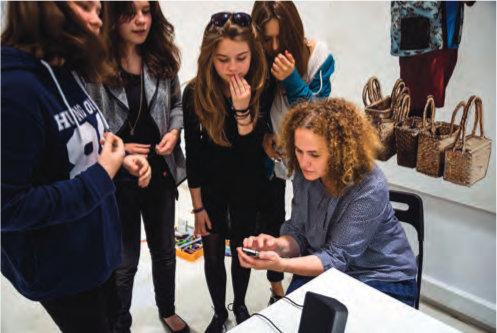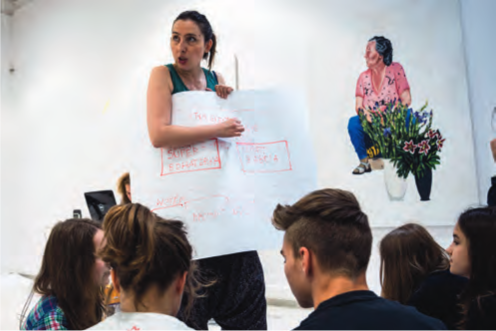Musical Images
By five to nine in the morning, twelve secondary-school students have already turned up at the Zachęta workshop room.
I am waiting for them with a complete set of instruments. Two paintings by Magda Bielesz hang on the walls — the beautiful, merry, colourful street vendors from the Sailor Moon series.
Magda will arrive around eleven to listen to musical compositions and spontaneous improvisations inspired by her works. This is the last meeting this school year in the Musical Images series, which has as its protagonists ten selected works from the Zachęta collection and a group of students from a Warsaw secondary school. Texture, Word , Time, Nature against Nature, Authors about Themselves, Interpretation, Tools and Techniques, Inspiration, Rhythm — the subjects of the successive meetings became a challenge for me and the other educators running the project. A challenge and aninvitation to search for educational ‘solutions’ and transcriptions of the complex nature of contemporary art.
What kind of a challenge was it? Unique, unfolding in a space constituted by a confrontation of image and sound. Suggesting simple and pleasant solutions, being governed by an unexpected obviousness of relationships and a lexicon of communication codes we built together.
The September exhibition is a culmination of the year-long project, a reward for the students and parents, but also an invitation to experiment and play with contemporary art in the field of education.
The educational project has its roots in artistic practices and comes as a natural consequence of the artistic path that the band Kwartludium initiated in 2006, recording their debut album for the label Dux. Images by Pola Dwurnik, Twożywo, Karol Radziszewski, Anna Okrasko, and Adam X appeared on that album in the part titled ‘In-strumental Interpretations of Visual Works’; we used them as contemporary scores. With time, playing to works of visual art became a regular feature of the band’s live repertoire, gaining eventually the name Musical Images. There was a strong desire in us to be close to the audience. Live expression and improvisation was always preceded by a process of building and explaining meanings. Thus wonderful experience of group work, different from the exciting, but tedious struggling through the scores of contemporary composers, resulted in an educational project.
Building meanings, explaining, learning, understanding and natural expression became an artistic act in which the viewer becomes the author and which we can share. I am sure that my students will attend this year’s Warsaw Autumn concerts on their own will and with pleasure. Dagna Sadkowska




No School Discipline
Throughout the school year you participated in the Musical Images project. What was it that you particularly liked about it?
– We liked the classes themselves, it was something different from sitting behind the desks at school.
– There was not only music but also art and pictures, so we could learn a lot, get to know new techniques, artists.
– Sometimes we liked a piece because we liked its particular technique. That was the case with [Włodzimierz Pawlak’s] Poles Forming Their National Flag. I was surprised that it’s possible to create such a powerful effect by simply squeezing out paint from the tube, sweeping it aside with a ruler and painting lines.
– For me it was incredible that virtually all aspects of a painting — colour, lines etc.
— can be applied to music. I used to think they were two completely different things, but now I see they are very similar.
– I loved the class when we went out to the main lobby and built an installation. It was so unusual — not just music and drawing, but physical action where we could use found objects.
– Playing for the Zachęta staff [musical improvisations on a set theme] was also interesting — so spontaneous.
– Or going outdoors and taking pictures.
– Asking people [passers-by at Park Saski] what ‛inspiration’ is. The replies were highly varied.
– I liked the last meeting where the artist [Magda Bielesz] was present and we could learn something interesting about her and her life.
– … and the painting process itself. The prospect of meeting a person from the art world is an interesting one.
– Another advantage was that Ms. Sadkowska gave us a lot of latitude. We could show initiative, play something that we liked. There was no strict discipline.
– Such classes give you an opportunity to learn things you wouldn’t get to know about in everyday life, see things you normally don’t see, and play contemporary music which I, for one, don’t listen to’.
What were the advantages of attending extramural classes?
– We learned new things.
– Our perception of Zachęta has changed.
– We got to know many paintings, not only those we played to.
– It’s cool the paintings were here. Had we been at school, we’d have seen them on slides only and here we could regard the originals’.Imagine you attend just one such class at Zachęta and then go back to school. Is it a value that the project is cyclical and runs throughout the year?
– If I had attended just one meeting, I’d only have grown even more wary of contemporary art. A single class would have been for nothing. We’d have remembered something and forgotten it a week later. When it’s a series, some things are repeated.
Has participation in this project changed the way you perceive contemporary music?
– Music is stranger [than art], I have even more qualms about it…
– I loved it when we listened to a recording of a beatbox played on flute. I was surprised you can play something like this on such a classical instrument. John Cage’s 4 ́33 ́ ́ was interesting and also weird. Attending such classes, you can learn something new.
– I’m still not convinced about this music. It’s very ingenuous and certainly fun to play, but it’s not something you could listen to every day.
– Okay, once, but if I were listen to it on a daily basis, I’d rather go for classical music.
And how have the classes changed your attitude to art?
– At first, I remember, everyone was sceptical about contemporary art and music. But then our attitude changed.
– I didn’t know contemporary art before, only from other people’s accounts. I got to like it. When we visit an exhibition, we often don’t reflect at all on what we see because that’s the easier way. And here we discuss how the given piece was painted, how to play to it, we got to know it inside out.
– We recently had an extramural class at the National Museum and viewed classical paintings: landscapes, portraits etc. My conclusion was that they are generally boring. I was surprised to realise contemporary art fascinates me more. I had my doubts at first.
– I also had doubts at the beginning of the project. I didn’t know what to think about contemporary art. Now I’ve been warming up to it.
– I also had my doubts and still prefer old art. Ms. Sadkowska is a nice teacher but contemporary art still doesn’t appeal to me, this hasn’t changed.
– I think contemporary art is more intellectually stimulating. Of course, there are also works of old art that are very beautiful and tackle subjects that are thoughtprovoking, but in contemporary art this happens much more often. I recently visited Zachęta on the Night of Museums and what I saw there got me interested. Some works are highly controversial, there are moments of discouragement, but generally I’d say the project has had a very favourable influence on me.
– From now on, I think, when I see a painting, I’ll be analysing it the way we did during the classes.
– I’ll also be giving a lot of thought to the author. Previously I never thought about him before.
Agata Wolfowicz, Basia Stypuła, Jasmin Mmereole, Emilia Hołody, Oa Zbarachewicz, Martyna Cyganek, Bartosz Berger, Bogdan Białek, Olaf Dąbrowski, Jeremi Dziedziejko, Jan Gradoń and Szymon Oktaba talk to Maria Świerżewska-Franczak and Anna Zdzieborska.